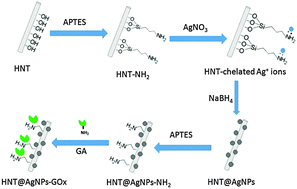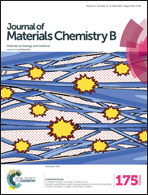Surface functionalized halloysite nanotubes decorated with silver nanoparticles for enzyme immobilization and biosensing†
Abstract
Improving enzyme immobilization with high loading capacity and achieving direct electron transfer (DET) between the enzyme and the electrode surface is key to designing highly sensitive enzymatic electrochemical biosensors. Herein, we report a novel approach based on the selective modification of the outer surface of halloysite nanotubes (HNTs) that supports silver nanoparticles (AgNPs) to obtain a hybrid nanocomposite. AgNPs of about 10 nm average size could be uniformly supported on silane-modified HNTs through in situ reduction of Ag+ ions. The resultant nanocomposite shows an excellent support capability for the effective immobilization and electrical wiring of redox enzyme glucose oxidase (GOx). The GOx immobilized HNT/AgNPs were deposited on the glassy carbon electrode (GCE) and utilized for the bioelectrocatalyzed electrochemical detection of glucose. The GOx modified composite electrodes show glucose sensitivity as high as 5.1 μA mM−1 cm−2, which is higher than for the electrodes prepared without surface functionalization.

- This article is part of the themed collections: JMC B Editor’s choice web collection: ‘‘seeing the unseen updated: advances in biosensing’’ and 2016 Journal of Materials Chemistry B Hot Papers

 Please wait while we load your content...
Please wait while we load your content...